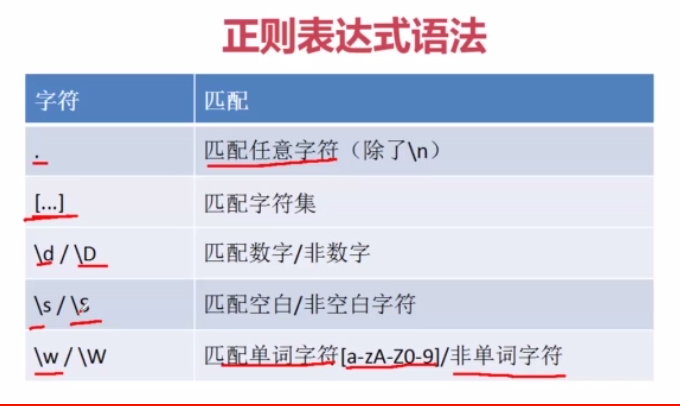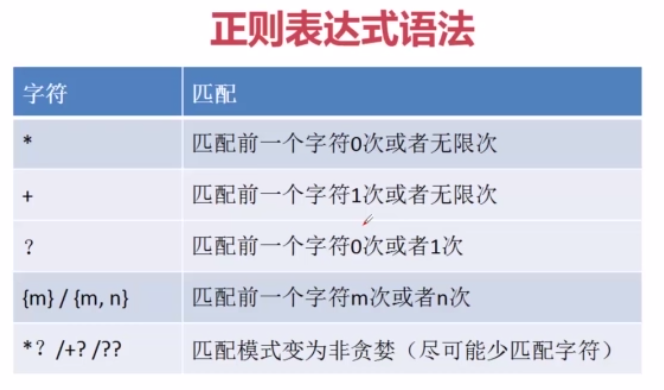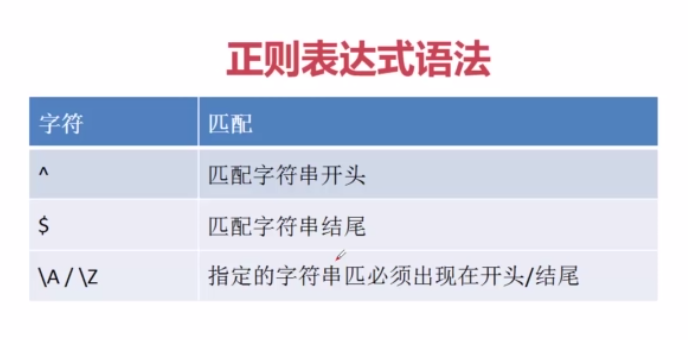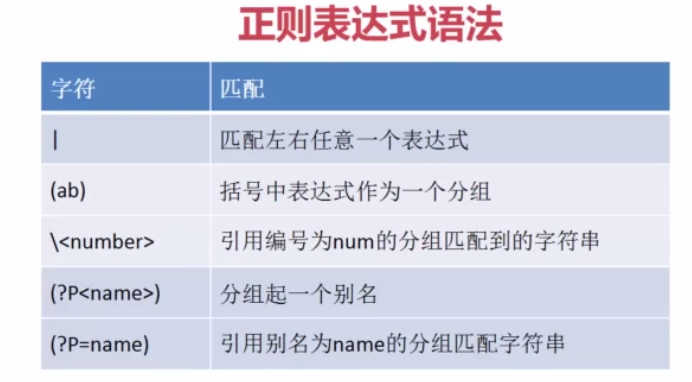python 正則表示式基礎實戰
阿新 • • 發佈:2019-02-18
python正則表示式的過程大致如下圖:
首先,通過re.compile()函式,生成pattern物件,該物件可以多次使用。
然後呼叫pattern物件的match(string)方法,在string中進行匹配,匹配成功後,返回 一個match物件,
通過呼叫match物件的group()方法,可以檢視匹配到的資訊。。。。
下面,我們簡單示例一下:
上面的示例,我們都是先呼叫re.compile()方法,生成一個pattern物件,然後再呼叫該pattern物件的match()方法,這兩步可以合併為一步,如下:>>> p=re.compile(r'imooc')#生成pattern物件,該物件可以多次使用 >>> p <_sre.SRE_Pattern object at 0x7f121d1a2418> >>> type(p) <type '_sre.SRE_Pattern'> >>> m=p.match('imoocabc')#生成match物件 >>> m <_sre.SRE_Match object at 0x7f121d194238> >>> type(m) <type '_sre.SRE_Match'> >>> m.group()#匹配到的子串 'imooc' >>> m.string #被匹配的字串 'imoocabc' >>> m.span() #匹配到的子串在原字串中的索引位置 (0, 5) >>> m.re #pattern例項 <_sre.SRE_Pattern object at 0x7f121d1a2418> >>> >>> p=re.compile(r'imooc') >>> m=p.match('IMOOcjfjd')#匹配失敗,因為區分大小寫 >>> type(m) <type 'NoneType'> >>> m.group() Traceback (most recent call last): File "<stdin>", line 1, in <module> AttributeError: 'NoneType' object has no attribute 'group' >>> p=re.compile(r'imooc',re.I)#re.I表示忽略(ignore)大小寫 >>> p <_sre.SRE_Pattern object at 0x7f121d1b71f8> >>> type(p) <type '_sre.SRE_Pattern'> >>> m=p.match('imoocjdf') >>> m.group() 'imooc' >>> m=p.match('IMOOcjdf') >>> m.group() 'IMOOc' >>> >>> p=re.compile(r'(imooc)',re.I)#將imooc放到圓括號中 >>> p <_sre.SRE_Pattern object at 0x7f121f265f48> >>> m=p.match('iMOOCidf') >>> m <_sre.SRE_Match object at 0x7f121d1d9198> >>> m.group() 'iMOOC' >>> m.groups()#將imooc放到圓括號中,m.groups()會返回一個元組 ('iMOOC',) >>>
上面是正則表示式的簡單使用,現在,我們學習正則表示式的基礎語法:>>> m=re.match(r'imooc','imoocjdf')#先生成pattern物件,再生成match物件,缺點:生成的pattern物件只使用了一次! >>> m <_sre.SRE_Match object at 0x7f121f2c2ac0> >>> type(m) <type '_sre.SRE_Match'> >>> m.group() 'imooc'
【1】匹配單個字元
1》
.:用來匹配任意一個字元(不包含'\n')
2》>>> m=re.match(r'.','adg') >>> m.group() 'a' >>> m=re.match(r'.','123adg') >>> m.group() '1' >>> m=re.match(r'.','@123adg') >>> m.group() '@' >>> m=re.match(r'.','%@123adg') >>> m.group() '%' >>> m=re.match(r'.','\n%@123adg')# .無法匹配'\n' >>> m.group() Traceback (most recent call last): File "<stdin>", line 1, in <module> AttributeError: 'NoneType' object has no attribute 'group' >>> type(m) <type 'NoneType'> >>> m=re.match(r'{.}','{a}\n%@123adg') >>> m.group() '{a}' >>> m=re.match(r'{.}','{8}\n%@123adg') >>> m.group() '{8}' >>> m=re.match(r'{.}','{8ab}\n%@123adg') >>> m.group() Traceback (most recent call last): File "<stdin>", line 1, in <module> AttributeError: 'NoneType' object has no attribute 'group' >>> type(m) <type 'NoneType'> >>> m=re.match(r'{...}','{8ab}\n%@123adg') >>> m.group() '{8ab}'
[a-z]匹配a-z中的任意一個字元 [0-9]匹配0-9中的任意一個字元
>>> m=re.match(r'{[abc]}','{b}\n%@123adg')
>>> m.group()
'{b}'
>>> m=re.match(r'{[abc]}','{g}\n%@123adg')
>>> m.group()
Traceback (most recent call last):
File "<stdin>", line 1, in <module>
AttributeError: 'NoneType' object has no attribute 'group'
>>> type(m)
<type 'NoneType'>
>>> m=re.match(r'{[a-z]}','{g}\n%@123adg')
>>> m.group()
'{g}'
>>> m=re.match(r'{[a-zA-Z]}','{H}\n%@123adg')
>>> m.group()
'{H}'
>>> m=re.match(r'[[a-z]]','[d]g%@123adg')#匹配失敗,應用'\['來匹配'['
>>> m=re.match(r'([a-z])','(d)kdjkf') #匹配失敗,應用'\('來匹配'('
\W代表一個非單詞字元(\w的對立面)
>>> m=re.match(r'{[\w]}','{H}\n%@123adg')
>>> m.group()
'{H}'
>>> m=re.match(r'{[\w]}','{h}\n%@123adg')
>>> m.group()
'{h}'
>>> m=re.match(r'{[\w]}','{9}\n%@123adg')
>>> m.group()
'{9}'
>>> m=re.match(r'{[\w]}','{&}\n%@123adg')
>>> m.group()
Traceback (most recent call last):
File "<stdin>", line 1, in <module>
AttributeError: 'NoneType' object has no attribute 'group'
>>> type(m)
<type 'NoneType'>
>>> m=re.match(r'{[\W]}','{&}\n%@123adg')
>>> m.group()
'{&}'\D匹配一個非數字
>>> m=re.match(r'\d','9agd')
>>> m.group()
'9'
>>> m=re.match(r'\d','0agd')
>>> m.group()
'0'
>>> m=re.match(r'\d','ghh0agd')
>>> m.group()
Traceback (most recent call last):
File "<stdin>", line 1, in <module>
AttributeError: 'NoneType' object has no attribute 'group'
>>> m=re.match(r'\D','ghh0agd')
>>> m.group()
'g'
>>> m=re.match(r'\D','Aghh0agd')
>>> m.group()
'A'
>>> m=re.match(r'\D','+Aghh0agd')
>>> m.group()
'+'
>>> m=re.match(r'\D','*+Aghh0agd')
>>> m.group()
'*'\S匹配非空白字元
>>> m=re.match(r'\s',' *+Aghh0agd')
>>> m.group()
' '
>>> m=re.match(r'\S','*+Aghh0agd')
>>> m.group()
'*'
>>> m=re.match(r'\S','$Aghh0agd')
>>> m.group()
'$'
>>> m=re.match(r'\S','h$Aghh0agd')
>>> m.group()
'h'1》* 匹配前一個字元0次或者無限次(任意次)
>>> m=re.match(r'[A-Z][a-z]*','H')
>>> m.group()
'H'
>>> m=re.match(r'[A-Z][a-z]*','Hjdkjfksdjkff')
>>> m.group()
'Hjdkjfksdjkff'
>>> m=re.match(r'[A-Z][a-z]*','Hjdkjf98ksdjkff')
>>> m.group()
'Hjdkjf'
>>> m=re.match(r'[_a-zA-Z][\w]*','_this')
>>> m.group()
'_this'
>>> m=re.match(r'[_a-zA-Z][\w]*','_')
>>> m.group()
'_'
>>> m=re.match(r'[_a-zA-Z][\w]*','3abc')
>>> m.group()
Traceback (most recent call last):
File "<stdin>", line 1, in <module>
AttributeError: 'NoneType' object has no attribute 'group'>>> m=re.match(r'A[0-9]+','A')
>>> m.group()
Traceback (most recent call last):
File "<stdin>", line 1, in <module>
AttributeError: 'NoneType' object has no attribute 'group'
>>> m=re.match(r'A[0-9]+','A8')
>>> m.group()
'A8'
>>> m=re.match(r'A[0-9]+','A88787gg')
>>> m.group()
'A88787'>>> m=re.match(r'[1-9]?[0-9]','100')
>>> m.group()
'10'
>>> m=re.match(r'[1-9]?[0-9]','990')
>>> m.group()
'99'
>>> m=re.match(r'[1-9]?[0-9]','0990')
>>> m.group()
'0'4》{m}/{m,n}匹配起一個字元m次或者m到n次
>>> m=re.match(r'[a-z0-9]{6}','123abckkk')
>>> m.group()
'123abc'
>>> m=re.match(r'[a-z0-9]{6}','123ab')
>>> m.group()
Traceback (most recent call last):
File "<stdin>", line 1, in <module>
AttributeError: 'NoneType' object has no attribute 'group'
>>> m=re.match(r'[a-z0-9]{6}@163.com','[email protected]')
>>> m.group()
'[email protected]'
>>> m=re.match(r'[a-z0-9]{6,10}@163.com','[email protected]')
>>> m.group()
'[email protected]'
>>> m=re.match(r'[a-z0-9]{6,10}@163.com','[email protected]')
>>> m.group()
'[email protected]'
>>> m=re.match(r'[a-z0-9]{6,10}@163.com','[email protected]')
>>> m.group()
Traceback (most recent call last):
File "<stdin>", line 1, in <module>
AttributeError: 'NoneType' object has no attribute 'group'
>>> m=re.match(r'[a-z0-9]{6,10}@163.com','[email protected]')
>>> m.group()
Traceback (most recent call last):
File "<stdin>", line 1, in <module>
AttributeError: 'NoneType' object has no attribute 'group'5》*? +? ??匹配模式變為非貪婪(儘可能少的匹配字元)
>>> m=re.match(r'a[0-9]*','a90987abc')
>>> m.group()
'a90987'
>>> m=re.match(r'a[0-9]*?','a90987abc')
>>> m.group()
'a'
>>> m=re.match(r'a[0-9]+','a90987abc')
>>> m.group()
'a90987'
>>> m=re.match(r'a[0-9]+?','a90987abc')
>>> m.group()
'a9'
>>> m=re.match(r'a[0-9]?','a90987abc')
>>> m.group()
'a9'
>>> m=re.match(r'a[0-9]??','a90987abc')
>>> m.group()
'a'1》^ 匹配字串的開頭(match預設就是從頭開始匹配)
2》$ 匹配字串的結尾
>>> m=re.match(r'[\w]{6,10}@163.com','[email protected]') #match預設就是從頭開始匹配
>>> m.group()
'[email protected]'
>>> m=re.match(r'^[\w]{6,10}@163.com','[email protected]') #顯式指定從頭開始匹配
>>> m.group()
'[email protected]'
>>> m=re.match(r'^[\w]{6,10}@163.com$','[email protected]') #指定必須以@163.com結尾
>>> m.group()
Traceback (most recent call last):
File "<stdin>", line 1, in <module>
AttributeError: 'NoneType' object has no attribute 'group'
>>> m=re.match(r'^[\w]{6,10}@163.com$','[email protected]') #指定必須以@163.com結尾
>>> m.group()
'[email protected]'3》\A \Z 指定的字串必須出現在開頭/結尾
>>> m=re.match(r'\Aimooc[0-9]+','imooc123')
>>> m.group()
'imooc123'
>>> m=re.match(r'\Aimooc[0-9]+','iimooc123')
>>> m.group()
Traceback (most recent call last):
File "<stdin>", line 1, in <module>
AttributeError: 'NoneType' object has no attribute 'group'
>>> m=re.match(r'[0-9]+imooc\Z','123imooc')
>>> m.group()
'123imooc'
>>> m=re.match(r'[0-9]+imooc\Z','123imoocbook')
>>> m.group()
Traceback (most recent call last):
File "<stdin>", line 1, in <module>
AttributeError: 'NoneType' object has no attribute 'group'
1》 | 匹配左右任意一個表示式
>>> m=re.match(r'abc|d','abckkk')
>>> m.group()
'abc'
>>> m=re.match(r'abc|d','dabckkk')
>>> m.group()
'd'
>>> m=re.match(r'[1-9]?[0-9]|100','0')
>>> m.group()
'0'
>>> m=re.match(r'[1-9]?[0-9]|100','59')
>>> m.group()
'59'
>>> m=re.match(r'[1-9]?[0-9]|100','100')
>>> m.group()
'10'
>>> m=re.match(r'[1-9]?[0-9]$|100','100')
>>> m.group()
'100'2》(163|126|qq)括號中的表示式作為一個分組,任選其中一個
>>> m=re.match(r'[\w]{4,6}@(163|126|qq).com','[email protected]')
>>> m.group()
'[email protected]'
>>> m=re.match(r'[\w]{4,6}@(163|126|qq).com','[email protected]')
>>> m.group()
'[email protected]'
>>> m=re.match(r'[\w]{4,6}@(163|126|qq).com','[email protected]')
>>> m.group()
'[email protected]'
>>> m=re.match(r'[\w]{4,6}@(163|126|qq).com','[email protected]')
>>> m.group()
Traceback (most recent call last):
File "<stdin>", line 1, in <module>
AttributeError: 'NoneType' object has no attribute 'group'3》\number 引用編號為number的分組所匹配到字串
>>> m=re.match(r'<([\w]+>)\1\1','<book>book>book>')
>>> m.group()
'<book>book>book>'
>>> m.groups()
('book>',)
>>> m=re.match(r'<([\w]+>)[\w]+</\1','<book>python</book>')
>>> m.groups()
('book>',)
>>> m.group()
'<book>python</book>'>>> m=re.match(r'<(?P<mark>[\w]+>)[\w]+</\1','<book>python</book>') #通過編號引用
>>> m.group()
'<book>python</book>'
>>> m=re.match(r'<(?P<mark>[\w]+>)[\w]+</(?P=mark)','<book>python</book>')#通過別名引用
>>> m.group()
'<book>python</book>'上面我們學習了,正則表示式的基礎語法,接著,我們簡單學習一下python中的正則表示式模組-----re模組
使用該模組,首先要匯入:import re
1》search(pattern,string,flags=0) 在一個字串中查詢匹配,返回第一個匹配
>>> s='imooc hours=1000'
>>> m=re.search(r'\d+',s)
>>> m
<_sre.SRE_Match object at 0x7fb4ae3da4a8>
>>> m.group()
'1000'
>>> s='imooc c++=1230,python=1200'
>>> m=re.search(r'\d+',s)
>>> m
<_sre.SRE_Match object at 0x7fb4ae3da4a8>
>>> m.group()
'1230'>>> s='c++=100,java=200,python=300'
>>> m=re.search(r'\d+',s)#返回第一個匹配
>>> m
<_sre.SRE_Match object at 0x7fb4ae3da578>
>>> m.group()
'100'
>>> info=re.findall(r'\d+',s) #返回所有匹配部分的列表
>>> info
['100', '200', '300']將字串中匹配正則表示式的部分替換為其他值
3.1>repl是字串
>>> s='imooc c++=1000'
>>> info=re.sub(r'\d+','1001',s)
>>> info
'imooc c++=1001'
>>> s='imooc c++=1000,python=2000'
>>> info=re.sub(r'\d+','1001',s)
>>> info
'imooc c++=1001,python=1001'sub(pattern,repl,string,count=0,flags=0) 若果repl是函式物件,則該函式接收的引數是一個match物件,
首先,對正則表示式pattern進行編譯,生成一個pattern物件,
然後,使用該pattern物件,在字串string中進行匹配,匹配成功,返回一個match物件,
最後,將該match物件,傳遞給repl函式!!!
【該部分程式碼可以幫助理解上述說明!!
>>> p=re.compile(r'\d+')
>>> p
<_sre.SRE_Pattern object at 0x7fb4ae486a48>
>>> m=p.match('123sdjf')
>>> m
<_sre.SRE_Match object at 0x7fb4ae3da4a8>
>>> m.group()
'123'
】
>>> def add1(match):
... s=match.group()
... value=int(s)+1
... return str(value)
...
>>> s='imooc c++=1000,java=2000,python=3000'
>>> re.sub(r'\d+',add1,s)
'imooc c++=1001,java=2001,python=3001'>>> s='imooc:c c++ python java'
>>> re.split(r':| ',s) #指定 ':'或' '作為分隔符(可以指定多個分隔符!!!)
['imooc', 'c', 'c++', 'python', 'java']
>>> s='imooc:c c++ python java,c#'
>>> re.split(r':| |,',s) #指定 ':'或' '或','作為分隔符
['imooc', 'c', 'c++', 'python', 'java', 'c#']最後,我們通過一個簡單例項,來抓取網上的圖片:
import urllib2,re
req=urllib2.urlopen('http://www.imooc.com/course/list')
buf=req.read()
urllist=re.findall(r'http:.+\.jpg',buf)
print urllist
i=0
for url in urllist:
request=urllib2.urlopen(url)
buffer=request.read()
f=open('C:\\Users\\91135\\Desktop\\image\\'+str(i)+'.jpg','w')
f.write(buffer)
f.close()
i+=1至此,我們對python中的正則表示式有了一個基本的瞭解,另外兩篇介紹正則表示式的文章,推薦學習:





